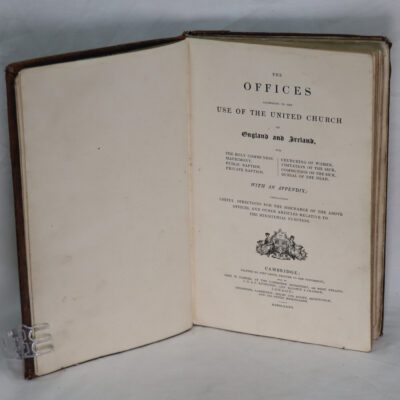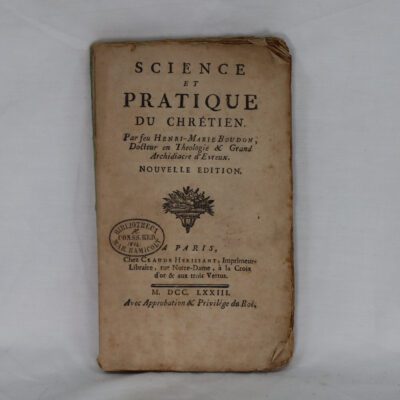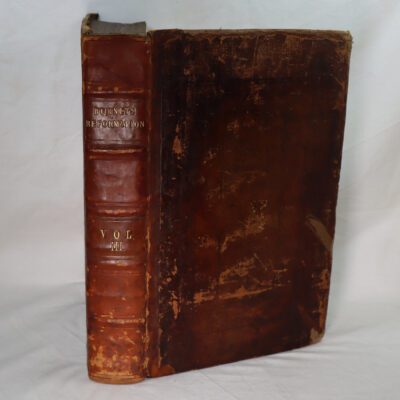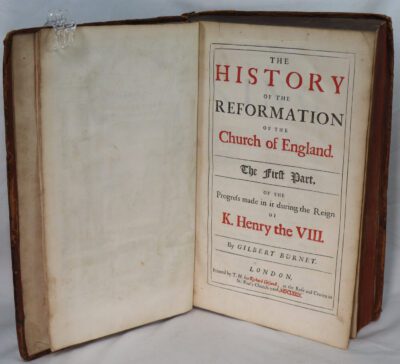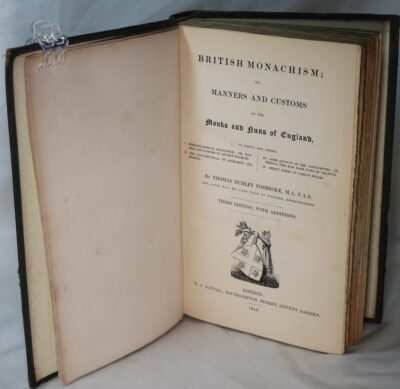Pilgrim's Progress.
By John Bunyan
Printed: Circa 1880
Publisher: George Routledge & Sons. London
| Dimensions | 17 × 22 × 4 cm |
|---|---|
| Language |
Language: English
Size (cminches): 17 x 22 x 4
Condition: Fine (See explanation of ratings)
Item information
Description
Brown grained leather binding with raised black banding and gilt title on the spine. Gilt title on the front board. All edges gilt.
-
F.B.A. provides an in-depth photographic presentation of this item to stimulate your feeling and touch. More traditional book descriptions are immediately available.
Published in London in the 1860s as the final compilation of George Offor’s John Bunyan studies. This finely bound edition of one of the most significant works of religious English literature. It is illustrated with one hundred and ten designs by J.D. Watson engraved on wood by the Brothers Dalziel. With a Memoir and notes by George Offor. In very good condition. An exceptional presentation. First published in 1678, John Bunyan’s The Pilgrim’s Progress remains one of the most significant works of theological fiction in English literature, as well as one of the progenitors of the narrative aspect of Christian media.
The Pilgrim’s Progress from This World, to That Which Is to Come is a 1678 Christian allegory written by John Bunyan. It is regarded as one of the most significant works of theological fiction in English literature and a progenitor of the narrative aspect of Christian media.It has been translated into more than 200 languages and has never been out of print. It appeared in Dutch in 1681, in German in 1703 and in Swedish in 1727. The first North American edition was issued in 1681. It has also been cited as the first novel written in English. According to literary editor Robert McCrum, “there’s no book in English, apart from the Bible, to equal Bunyan’s masterpiece for the range of its readership, or its influence on writers as diverse as William Hogarth, C. S. Lewis, Nathaniel Hawthorne, Herman Melville, Charles Dickens, Louisa May Alcott, George Bernard Shaw, William Thackeray, Charlotte Bronte, Mark Twain, John Steinbeck and Enid Blyton.” The words on which the hymn “To be a Pilgrim” is based, come from the novel.
Bunyan began his work while in the Bedfordshire county prison for violations of the Conventicle Act 1664, which prohibited the holding of religious services outside the auspices of the established Church of England. Early Bunyan scholars such as John Brown believed The Pilgrim’s Progress was begun in Bunyan’s second, shorter imprisonment for six months in 1675, but more recent scholars such as Roger Sharrock believe that it was begun during Bunyan’s initial, more lengthy imprisonment from 1660 to 1672 right after he had written his spiritual autobiography Grace Abounding to the Chief of Sinners.
The English text comprises 108,260 words and is divided into two parts, each reading as a continuous narrative with no chapter divisions. The first part was completed in 1677 and entered into the Stationers’ Register on 22 December 1677. It was licensed and entered in the “Term Catalogue” on 18 February 1678, which is looked upon as the date of first publication. After the first edition of the first part in 1678, an expanded edition, with additions written after Bunyan was freed, appeared in 1679. The Second Part appeared in 1684. There were eleven editions of the first part in John Bunyan’s lifetime, published in successive years from 1678 to 1685 and in 1688, and there were two editions of the second part, published in 1684 and 1686.
John Bunyan (1628 – 31 August 1688) was an English writer and Puritan preacher. He is best remembered as the author of the Christian allegory The Pilgrim’s Progress, which also became an influential literary model. In addition to The Pilgrim’s Progress, Bunyan wrote nearly sixty titles, many of them expanded sermons.
Bunyan came from the village of Elstow, near Bedford. He had some schooling and, at the age of sixteen, joined the Parliamentary Army at Newport Pagnell during the first stage of the English Civil War. After three years in the army, he returned to Elstow and took up the trade of tinker, which he had learned from his father. He became interested in religion after his marriage, attending first the parish church and then joining the Bedford Meeting, a nonconformist group in St John’s church Bedford, and later became a preacher. After the restoration of the monarchy, when the freedom of nonconformists was curtailed, Bunyan was arrested and spent the next twelve years in prison because he refused to give up preaching. During this time, he wrote a spiritual autobiography, Grace Abounding to the Chief of Sinners, and began work on his most famous book, The Pilgrim’s Progress.
In 1676, Charles II withdrew his Act of Indulgence and four years later, Bunyan was again imprisoned – this time only for six months. During that time, he completed The Pilgrim’s Progress.
Bunyan’s later years were spent in relative comfort and he continued to be a popular author and preacher, and was the pastor of the Bedford Meeting. He died aged 59 after falling ill on a journey to London and is buried in Bunhill Fields. The Pilgrim’s Progress became one of the most published books in the English language; 1,300 editions had been printed by 1938, 250 years after the author’s death.
Bunyan is remembered in the Church of England with a Lesser Festival on 30 August. Some other churches of the Anglican Communion, such as the Anglican Church of Australia, honour him on the day of his death (31 August).
George Offor (1787– 7 August 1864) was an English book-collector who accumulated a massive personal library. Offor entered business as a bookseller at Tower Hill, London. He studied Hebrew, Greek and Latin and became an expert in sixteenth- and seventeenth-century English literature and theological writings. He had compiled the complete works of John Bunyan. However some of them were destroyed in a fire. He spent his days reading, researching, recording, comparing, and editing the works of Bunyan. Offor’s diligent labour concluded in 1854 with the printing of the three-volume, 2,800 page Works of John Bunyan. Now over a century and a half old, Offor’s final product remains the most popular definitive collection of Bunyan in print.
John Dawson Watson was a painter, watercolourist and illustrator. He studied at the Manchester School of Design and at the Royal Academy Schools. He exhibited at the Royal Academy 1853 to 1890, the British Institution, the Society of British Artists Suffolk Street, the Old Watercolour Society, the Grosvenor Gallery and elsewhere. Painted genre scenes, often of children. His pictures are usually small, painted on panel or board, and show a Pre-Raphaelite feeling for colour and detail. He was also a prolific and notable illustrator, producing many designs for books and periodicals. He worked for Once a Week, Good Words, London Society and others; among the many books he illustrated were Pilgrim’s Progress, Arabian Nights, and Watt’s Diine and Floral Songs. Works by him are in the Victoria and Albert Museum, Norwich and Liverpool.
The Brothers Dalziel was a prolific wood-engraving business in Victorian London, founded in 1839 by George Dalziel. In 1840, George (1 December 1815 – 4 August 1902) was joined in the business by his brother Edward Dalziel (1817–1905) and in subsequent years they were joined by their sister Margaret (1819–1894), brother John (1822–1869), and brother Thomas Dalziel (1823–1906). Along with at least three older brothers and one younger, they were children of the artist Alexander Dalziel of Wooler in Northumberland. George Dalziel trained under the wood-engraver Charles Gray in London from around 1835.
The Mad Pranks of Robin Goodfellow, by John Franklin, engraving by Edward Dalziel, 1845
The Dalziel Brothers worked with many important Victorian artists, producing illustrations for the burgeoning magazine and book market of the period.
An example of the Dalziel Brothers’ collaborations with illustrator Richard Doyle, in Sleeping Beauty (1868).
“As I slept, I dreamed a dream” (The Pilgrim’s Progress)
Among the artists they worked with were Arthur Boyd Houghton, Richard Doyle, Myles Birket Foster, John Gilbert, William Holman Hunt, John Everett Millais, John Proctor, Dante Gabriel Rossetti and James McNeill Whistler. They cut the illustrations to Edward Lear’s Book of Nonsense (1862); Lewis Carroll’s Alice in Wonderland and Through the Looking-Glass. They also produced independent ventures, most notably The Parables of Our Lord and Saviour Jesus Christ (London: Routledge, 1864), illustrated by Millais, and contributed humorous cartoons to magazines such as Fun, which George and Edward acquired in 1865. Until the advent of photo-mechanical processes c. 1880, they were pre-eminent in their trade. Examples of their work can be seen in the Victoria and Albert Museum in London. At the end of the nineteenth century they collaborated on an autobiographical summary of their work: The Brothers Dalziel, A Record of Work, 1840–1890 published by Methuen.
George Dalziel is buried in a family vault in the Egyptian Avenue in Highgate Cemetery. Edward Dalziel is buried in a family vault in the Circle of Lebanon in Highgate Cemetery.
Want to know more about this item?

Related products
Share this Page with a friend









